|
Printables |
PowerPoints |
Online exercises |
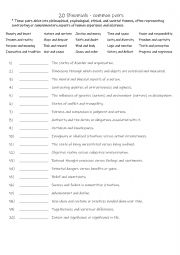
|
Binomials - common pairs of words 1c
These pairs delve into philosophical, psychological, ethical, and societal themes, often representing contrasting or complementary aspects of human experience and existence. This worksheet is suitable for B2-C1 students.Students read the definitions and find the corresponding pairs of words. This sheet can also be used for a speaking reinforcement ...
Level: advanced
Age: 12-100
Type:
Downloads: 124
|
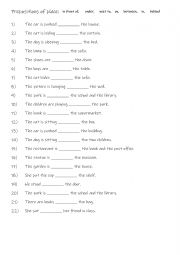
|
Prepositions of place in front of, under, next to, on, between, in, & behind
Students read the sentences and use the logical choice of prepositions to complete the gap-fill. This worksheet is suitable for A1- to low A2 students. Answers on page 2
Level: elementary
Age: 8-100
Type:
Downloads: 124
|
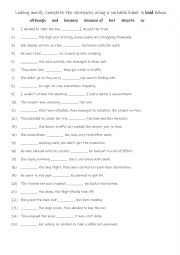
|
A2+-B1 Linking words. Complete the sentences using a suitable linker in bold below.
Linking words. Students complete the sentences using a suitable linker in bold below.
although and because because of but despite so. Answers on page 2.
Level: intermediate
Age: 10-100
Type: worksheet
Downloads: 124
|
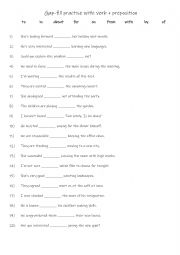
|
Gap-fill practise with verb + 9 prepositions
The gap-fill exercise provided is suitable for A2+-B1 level students. It involves common prepositions and phrases that are often used in everyday contexts, making it appropriate for learners who have a solid grasp of basic grammar and are ready to tackle more nuanced uses of prepositions. Answers on page 2.
Level: elementary
Age: 10-100
Type:
Downloads: 124
|
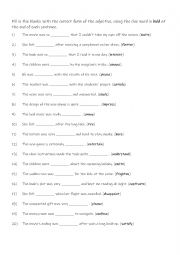
|
B1+ Complete the sentences with the correct form of the adjective -ed or -ing, using the verb form provided in bold font as a clue.
Using the correct form helps ensure that your message is understood as intended. Misusing these forms can lead to confusion or misinterpretation.Native speakers intuitively use these forms correctly, and learning them helps non-native speakers sound more natural and fluent. It�s a step toward mastering nuances in the language.Students fill in the b...
Level: intermediate
Age: 10-100
Type:
Downloads: 124
|
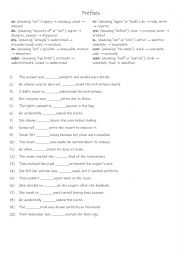
|
A2-B1 Prefixes with meanings & gap-fill practise
Understanding prefixes helps students decipher the meanings of unfamiliar words. For example, knowing that �un-� means �not� can help you understand that �unkown� means �not known.�Using and understanding prefixes can make your communication more precise. For instance, saying �preliminary� rather than �early� can convey more specific information ab...
Level: elementary
Age: 10-100
Type:
Downloads: 124
|
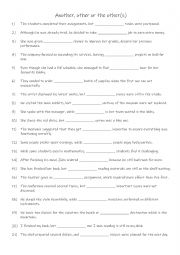
|
B1-B2 Another, other or the other(s) practise
These determiners and pronouns are important to master.Using these terms correctly helps you specify exactly what you are referring to, which prevents misunderstandings.These terms allow students to distinguish between items or people, which is crucial when comparing or contrasting.Knowing how to use these terms appropriately is important for effec...
Level: intermediate
Age: 10-100
Type:
Downloads: 124
|
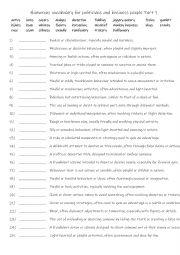
|
Humorous vocabulary for politicians and business people Part 1
Students familiarise themselves with the 25 words and their meanings. Then they read the definitions and write the word being described in the space provided. Answers on page 2.
Level: advanced
Age: 10-100
Type:
Downloads: 124
|
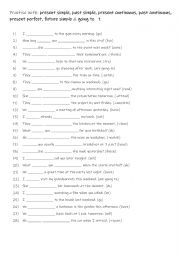
|
A2-B1 Practise with present simple, past simple, present continuous, past continuous, present perfect, future simple & going to 1
Students should practice the Present Simple, Past Simple, Present Continuous, Past Continuous, Present Perfect, Future Simple, and "Going to" tenses because these are fundamental to expressing a wide range of ideas in English. Mastering these tenses allows students to describe habits, routines, actions in progress, past events, completed actions, f...
Level: intermediate
Age: 8-100
Type:
Downloads: 124
|
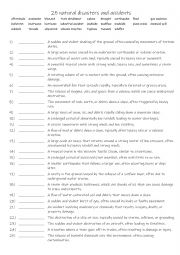
|
B1 25 natural disasters and accidents
Learning vocabulary related to natural disasters and accidents is crucial for understanding the impact of such events on communities, economies, and the environment. These terms enable students to communicate effectively in emergencies, describe events accurately, and engage in global conversations about disaster management and climate resilience. ...
Level: intermediate
Age: 10-100
Type:
Downloads: 124
|
|
|
|
|












